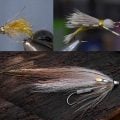Scientists: “Tarpon Actually Smallmouth Bass” (April Fool’s)

Smallmouth bass illustration courtesy of U.S. Fish and Wildlife Service. Tarpon llustration by Diana Rome Peebles, courtesy of Florida Fish and Wildlife Conservation Commission.
MARINE FISHERIES scientists across Florida have begun to agree begrudgingly with the results of a five-year university study, announced today, that proves conclusively that the Atlantic tarpon is actually a kind of smallmouth bass, having descended directly from an ancient, anadromous bronzeback.
Ichthyologists at Southern Florida Animist College (SFAC) compared cranial structures from fossils of the late Triassic Period species Teleosti aptenuro to the same anatomy in tarpon skulls. TheTeleosti aptenuro was a three-foot-long, ocean-going freshwater fish that gave rise to the smallmouth bass.
“Having compared over one hundred Atlantic tarpon skulls to the six perfect aptenurospecimens we have at the college, we found that a specific skull structure in tarpon — the “otolith,” or ear bone — matches that of the aptenuro in the same way that this structure in a smallmouth bass also matches,” says Dr. Claude Rouse, chief ichthyologist and leader of the five-year study at SFAC, which used MRI technology to map the inside of the Teleosti aptenuro skull.
“This specific skull structure appeared in the earliest known aptenuro, and then remained unchanged for the next 120 million years. So it is a very good marker of evolutionary origin if the same part in a living fish matches it,” Rouse said.
Rouse also studied the leaping techniques of both tarpon and smallmouth. Using computer modeling to track the range of motions of the tail and pectoral fins, and head-shaking of both species, the SFAC researchers found that smallmouth and tarpon fighting tactics are mirror images — smallmouth usually leap toward the sun when fighting, while tarpon leap away — following the same pattern of moment.
“Bodily, the tarpon exhibits a lot of adaptations for saltwater life, but uses them in the same exact fighting tactics as a smallmouth,” Rouse said, “But with the structures that really count, in the tarpon skull, you have a smallmouth bass.”
Professor Henry Sjallens, of the State University of New York at Wilson, NY, and an expert on Lake Ontario and Lake Erie smallmouth, quickly agreed with the SFAC study. “I have long theorized that smallmouth in the Great Lakes descended from landlocked Teleosti aptenuro,” Sjallens says. “We also know that Teleosti aptenuro is unique to prehistoric North America. Somehow, this animal gave rise to both smallmouth and tarpon, but tarpon are clearly a smallmouth-derived species, because we know smallmouth are older.”
Ichthyologists will now have to debate a scientific name change for the Atlantic tarpon. The real question is: Does this change anything for tarpon angling?
“A tarpon is a tarpon,” said Oliver Slatt, a tarpon guide on Ascension Bay, Yucatan. “You could say that a tarpon descends from the platypus and people will still fly all the way from New York City to catch one.”
Other tarpon lovers are skeptical.
“Two words: Silver. King!” said Stanton Rudleigh, president of the Boca Raton Tarpon Society. “Pound for pound, the tarpon is the greatest fish ever. Look at a tarpon, and then look at a smallmouth — you’re telling me you’ve got the same fish? I got bones in my head that probably resemble monkey bones, but I didn’t descend from any damn ape. This is baloney.”
The Smallmouth Angler Sportsmen’s Society (SASS), based in Scranton, PA, issued a short statement after SFAC released the results of the study: “We welcome the tarpon into the smallmouth-bass family. This is a great day for both fish, and for the anglers who pursue them. We invite all tarpon anglers to visit our showroom in Scranton. Donations for our creating a new, tarpon-focused wing of our showroom can be sent to us via our multimedia website, www.sass.ru.4reel.tv.”











